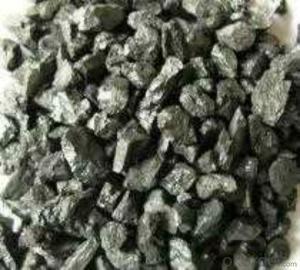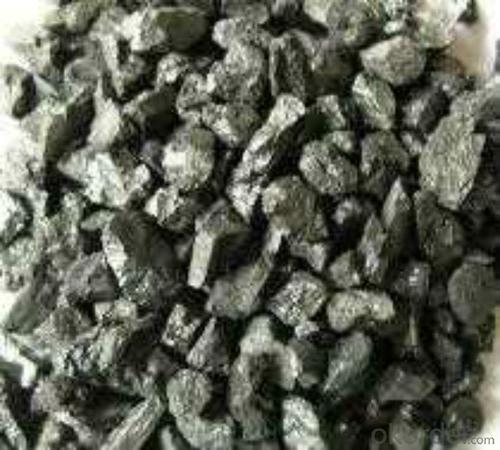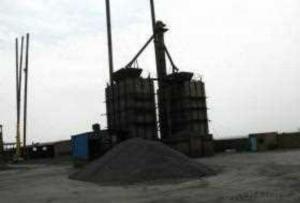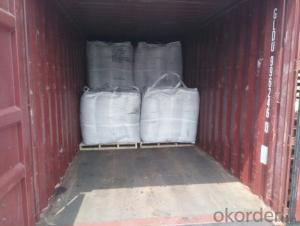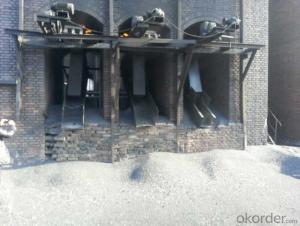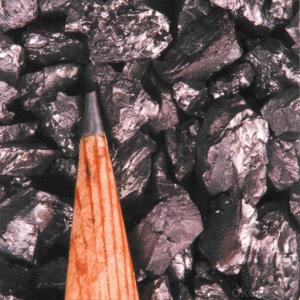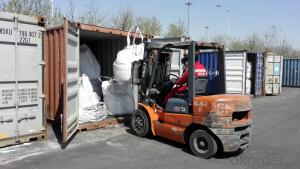FC93 Calcined Anthracite Coal in Low Sulphur as charging coke
- Loading Port:
- Tianjin
- Payment Terms:
- TT or LC
- Min Order Qty:
- 20 m.t.
- Supply Capability:
- 9500 m.t./month
OKorder Service Pledge
OKorder Financial Service
You Might Also Like
Specification
Introduction
Carbon Additive/Calcined Anthracite Coal may substitute massively refinery coke or graphite. Meanwhile its cost is much less than the refinery coke and graphite. Carbon Additive is mainly used in electric steel ovens, water filtering, rust removal in shipbuilding and production of carbon material.
Features
Carbon Additive also called Calcined anthracite Coal, Gas Calcined Anthracite Coal, Carbon Raiser, Recarburizer, injection coke, charging coke and etc.
The main raw material of our Carbon Additive is Ningxia unique high quality Taixi anthracite, with characteristic of low ash and low sulfur. Carbon additive has two main usage, fuel and additive. When being used as the carbon additive of steel-smelting, and casting, the fixed carbon may achieve above 95%. it is playing more and more important role in the industry.
Best quality Taixi anthracite as raw materials through high temperature calcined at 1200-1250 ℃ for 24 hours by the DC electric calciner with results in eliminating the moisture and volatile matter from Anthracite efficiently, improving the density and the electric conductivity and strengthening the mechanical strength and anti-oxidation, It has good characteristics with low ash, low resistivity, low carbon and high density. It is the best material for high quality carbon products, it is used as carbon additive in steel industry or fuel.It is becoming more and more popular in the steel industry. We have built a long-term relationship with major steel plants in the world
Specifications
PARAMETER UNIT GUARANTEE VALUE | |||||
F.C.% | 95MIN | 94MIN | 93MIN | 92MIN | 90MIN |
ASH % | 4MAX | 5MAX | 6MAX | 7MAX | 8MAX |
V.M.% | 1 MAX | 1MAX | 1.5MAX | 1.5MAX | 1.5MAX |
SULFUR % | 0.5MAX | 0.5MAX | 0.5MAX | 0.5MAX | 0.5MAX |
MOISTURE % | 0.5MAX | 0.5MAX | 0.5MAX | 0.5MAX | 0.5MAX |
Pictures
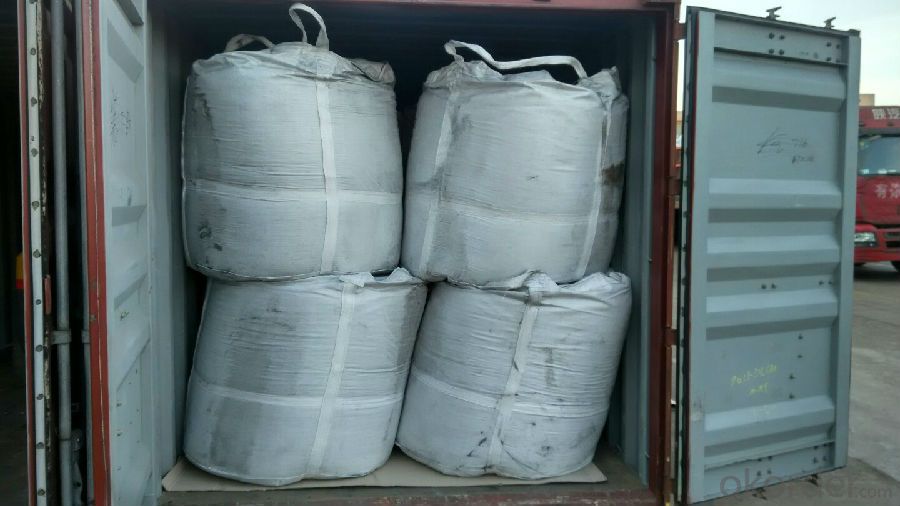
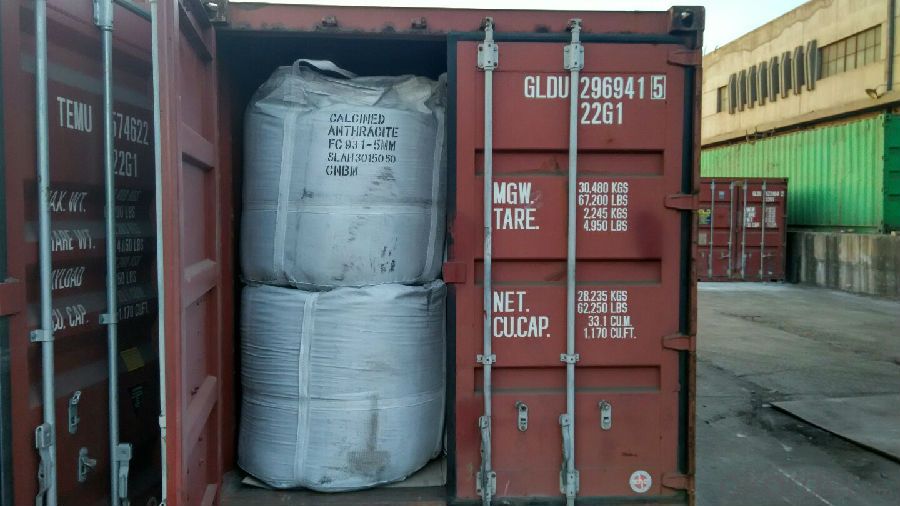
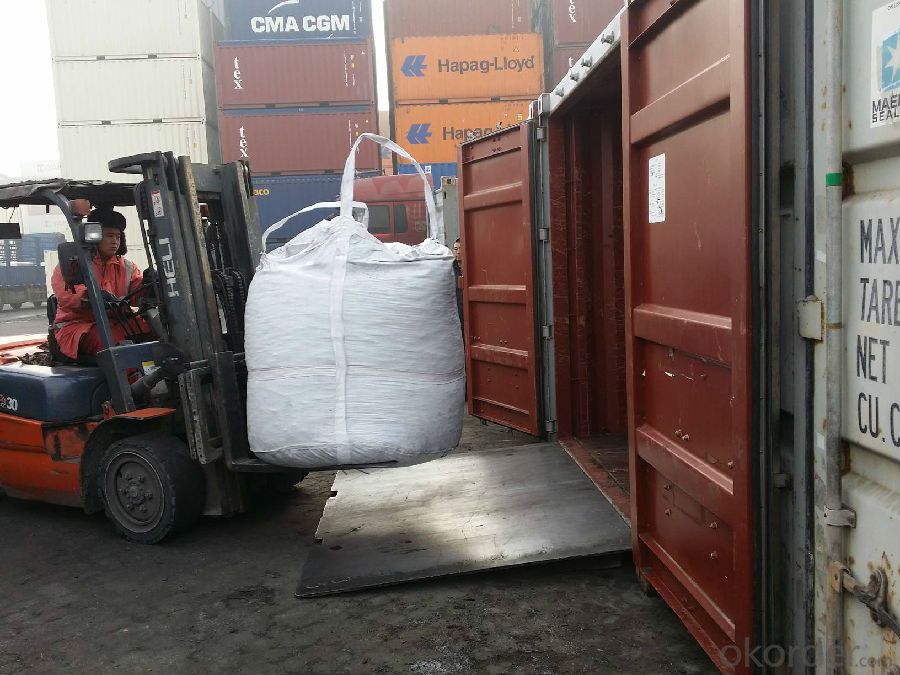
FAQ:
What is the packing?
In 25kg bag/ In jumbo bags without pallet/ Two jumbo bags with one pallet/ or as customers’ request
2. What is the production capacity?
10 thousand tons per month
3 What is payment term?
Irrevocable LC at sight/ 20% down payment by T/T and 80% against BL copy byT/T/ or to be discussed
4 What is the service?
We will send sample to the third party(CIQ, CCIC, SGS,BV or to be discussed) for checking, and present the test certificate and loading repot of shipment.
- Q: What is diamond?
- Diamond is a precious gemstone that is highly valued for its exceptional hardness, brilliance, and rarity. It is a form of carbon that has undergone intense heat and pressure deep within the Earth's mantle, resulting in its unique crystal structure. Known for its dazzling sparkle, diamond is transparent and colorless, although it can also occur in various colors such as yellow, blue, pink, and green due to impurities present during its formation. Diamonds are renowned for their use in jewelry, as they are cut and polished into various shapes to maximize their brilliance. Additionally, diamonds possess remarkable durability and are commonly used in industrial applications such as cutting, grinding, and drilling due to their strength. Overall, diamond's extraordinary beauty, durability, and scarcity have made it one of the most sought-after gemstones in the world.
- Q: How does carbon impact the prevalence of landslides?
- Carbon, in the form of carbon dioxide (CO2), plays a significant role in impacting the prevalence of landslides. One of the primary ways carbon impacts landslides is through its contribution to climate change. Increased levels of CO2 in the atmosphere result in global warming, which alters weather patterns, precipitation levels, and the overall stability of slopes and landforms. Climate change caused by carbon emissions leads to more frequent and intense rainfall events in many regions. This increased rainfall can saturate soil and increase groundwater levels, making slopes more susceptible to landslides. Additionally, intense rainfall can erode the soil, further weakening the stability of slopes and increasing the likelihood of landslides. Another way carbon impacts the prevalence of landslides is through its impact on vegetation. Carbon dioxide is a vital component of photosynthesis, the process by which plants convert sunlight into energy. However, elevated levels of CO2 can affect plant growth and productivity. Plants play a crucial role in stabilizing slopes and preventing erosion through their extensive root systems. When carbon levels are high, plants may experience reduced growth, which weakens their ability to anchor the soil and protect against landslides. Moreover, carbon emissions contribute to the melting of glaciers and permafrost, which can trigger landslides in mountainous regions. Glaciers act as natural stabilizers, holding large amounts of rock and soil in place. When glaciers melt due to global warming, the sudden release of this material can trigger landslides and result in devastating consequences. In summary, carbon impacts the prevalence of landslides primarily through its contribution to climate change and its subsequent effects on weather patterns, vegetation growth, and the stability of slopes. Addressing carbon emissions and mitigating climate change is essential in reducing the occurrence and severity of landslides.
- Q: What are the impacts of carbon emissions on the stability of mountain glaciers?
- Mountain glaciers are significantly affected by carbon emissions, which have significant consequences for their stability. The release of carbon dioxide and other greenhouse gases into the atmosphere contributes to global warming and climate change. This rise in global temperatures directly impacts the health and stability of mountain glaciers. One of the main outcomes of increased carbon emissions is the accelerated melting of mountain glaciers. Warmer temperatures cause glaciers to melt at a faster pace, resulting in a decrease in their size and volume. This not only affects the visual appeal of these natural wonders but also has major implications for water resources and ecosystems. Mountain glaciers serve as natural reservoirs, holding water in the form of ice and gradually releasing it over time. This process helps regulate water flow in rivers and streams, ensuring a consistent water supply for downstream communities, agriculture, and ecosystems. However, as carbon emissions contribute to glacier melting, this natural water storage mechanism is disrupted. The loss of glaciers leads to reduced water availability during dry seasons and can result in water scarcity for communities dependent on glacier meltwater. Moreover, the retreat of mountain glaciers due to carbon emissions has ecological consequences. These glaciers provide critical habitats for various plant and animal species. The loss of glacier ice and associated ecosystems can have a ripple effect on the entire ecosystem, resulting in the decline or even extinction of species reliant on glacier-fed environments. The impacts of carbon emissions on mountain glaciers also extend beyond local communities and ecosystems. Glacial meltwater plays a significant role in the overall water supply in many regions globally. As glaciers shrink and vanish, the availability of water resources becomes uncertain, particularly in areas heavily reliant on glacier meltwater. This can potentially lead to conflicts over water resources and worsen existing tensions. In conclusion, the stability of mountain glaciers is severely affected by carbon emissions. The accelerated melting of glaciers disrupts water availability, threatens ecosystems, and presents challenges for water resource management. It is crucial to reduce carbon emissions to mitigate these impacts and preserve the integrity and functionality of mountain glaciers.
- Q: What is the composition of carbon in stainless steel?
- The quality and performance of steel are determined according to needs, and different elements should be included in different requirements(1) carbon, the higher the carbon content, the higher the hardness, but its plasticity and toughness are worse(2) sulfur is the harmful impurity in steel. The steel with high sulfur content is easy to crack when it is processed by high temperature. It is usually called hot brittleness(3) p; can make the plasticity and toughness of the steel decreased significantly, especially at low temperature is more serious, this phenomenon is called cold brittleness. In high-quality steel, sulfur and phosphorus must be strictly controlled. But on the other hand, sulfur and phosphorus containing high in low carbon steels, can make the cutting easily broken, is benefit to improve the machinability of the steel is.(4) manganese; can improve the strength of steel, can weaken and eliminate the adverse effects of sulfur, and can improve the hardenability of steel, manganese content of high alloy steel (Gao Menggang) has good abrasion resistance and other physical properties.(5) silicon; it can improve the hardness of steel; but the plasticity and toughness decrease; the steel used in the electrician contains a certain amount of silicon, which can improve the soft magnetic properties(6) tungsten can improve the red hardness and heat strength of steel, and can improve the wear resistance of steel
- Q: What are the impacts of carbon emissions on the stability of estuaries?
- Estuaries, delicate and unique ecosystems where freshwater and saltwater mix, are significantly impacted by carbon emissions. One of the main consequences is ocean acidification, which occurs when carbon dioxide from human activities like burning fossil fuels is absorbed by the ocean, increasing the water's acidity. This heightened acidity has detrimental effects on estuary stability. Estuaries are home to a diverse array of marine life, including fish, shellfish, and plants. However, the increased acidity disrupts the delicate balance of these ecosystems. Many shellfish species, like oysters and clams, rely on calcium carbonate to build their shells and skeletons. In more acidic waters, the availability of carbonate ions decreases, making it challenging for these organisms to form and maintain their protective structures. Consequently, shellfish populations decline, impacting the entire estuarine food chain. Moreover, increased acidity affects the reproductive processes of many marine organisms. Fish and other species that reproduce in estuaries may experience reduced reproductive success due to changes in water pH. This decline in population numbers leads to a loss of biodiversity within estuaries. Furthermore, rising sea levels caused by carbon emissions also impact estuary stability. As global temperatures increase, glaciers and ice caps melt, causing the sea level to rise. Estuaries, often situated in low-lying coastal areas, are particularly vulnerable. Rising sea levels can increase salinity levels in estuaries as saltwater intrudes further into freshwater areas. This disruption in the delicate balance affects the survival of plants and animals dependent on specific salinity levels. In conclusion, carbon emissions have various negative impacts on estuary stability. Ocean acidification disrupts the delicate balance, affecting the reproduction and survival of species. Rising sea levels caused by carbon emissions further destabilize estuaries by altering salinity levels. To protect and preserve these valuable ecosystems, it is crucial to reduce carbon emissions and mitigate the effects of climate change.
- Q: Is badminton all good as carbon or aluminum carbon? Does carbon fiber on the Internet mean total carbon?
- Of course, it's all carbon. It's OK. Good elasticity, toughness and strength. It's better than aluminum. Now the regular professional racket is all carbon fiber and high elastic carbon fiber, you go to the store to see the hang of the racket, you will know
- Q: Carbon steel with carbon steel, carbon steel yuan yuan is the same? The trouble to know the answer urgently
- For Fang Gang, bar, angle steel, steel, steel wire and other types. According to the shape of carbon structure round is carbon steel round. Especially carbon steel is often said in the past round. Such as 45# round steel. Carbon steel and carbon circle is not necessarily a variety.
- Q: What are the problems that should be paid attention to in the injection molding of the material? Who has some details about carbon fiber injection? Thank you for sharing
- Carbon fiber melting point at about 3000 degrees (isolation oxygen, oxygen, about 400 degrees will be oxidized), itself can not be injection processing, only carbon fiber filled plastic can be injection molding.
- Q: How does carbon impact the availability of clean drinking water?
- The availability of clean drinking water can be significantly affected by carbon through various processes. One major way carbon impacts water quality is through the formation of acid rain caused by carbon dioxide emissions. When carbon dioxide combines with water in the atmosphere, it forms carbonic acid, which can be extremely harmful to water bodies. Freshwater sources can be devastated by acid rain, primarily caused by the release of carbon emissions from industrial activities and the burning of fossil fuels. This can result in a decrease in the pH level of lakes, rivers, and groundwater, making the water more acidic. The increased acidity can harm aquatic life, destroy ecosystems, and make water sources unsuitable for drinking, agriculture, or industrial use. Furthermore, carbon can affect the availability of clean drinking water through its role in climate change. Excessive carbon emissions contribute to the greenhouse effect, leading to rising global temperatures and changes in weather patterns. These changes can cause prolonged droughts and intense rainfall events, both of which can have negative effects on water availability and quality. Climate change-induced droughts can cause water scarcity as precipitation patterns become less predictable and water sources dry up. This can result in conflicts over limited water resources and force communities to rely on contaminated or unsafe water sources. Conversely, intense rainfall events caused by climate change can lead to flooding, overwhelming sewage systems and contaminating drinking water with pollutants and pathogens. Additionally, carbon emissions are linked to the degradation of natural ecosystems, such as forests and wetlands, which play a crucial role in water purification. Forests act as natural filters, absorbing carbon dioxide and releasing oxygen, while wetlands naturally filter and cleanse water. When these ecosystems are destroyed or degraded due to deforestation or drainage, the availability of clean drinking water is further compromised. To conclude, carbon emissions have a significant impact on the availability of clean drinking water. Acid rain formation, climate change-induced droughts and floods, and the degradation of natural ecosystems all contribute to water scarcity and contamination. It is crucial to protect and reduce carbon emissions in order to ensure the availability of clean drinking water for both present and future generations.
- Q: How is carbon used in the production of carbon fiber?
- Carbon is used in the production of carbon fiber by being subjected to high temperatures and combined with other elements to create a material that is strong, lightweight, and resistant to heat and chemicals.
Send your message to us
FC93 Calcined Anthracite Coal in Low Sulphur as charging coke
- Loading Port:
- Tianjin
- Payment Terms:
- TT or LC
- Min Order Qty:
- 20 m.t.
- Supply Capability:
- 9500 m.t./month
OKorder Service Pledge
OKorder Financial Service
Similar products
Hot products
Hot Searches
